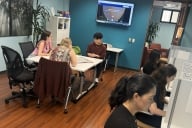You have /5 articles left.
Sign up for a free account or log in.
The enrollment of foreign students in undergraduate and graduate programs in the United States has suffered as a result of the worldwide economic crisis -- but perhaps not as much as many have feared, a report from the National Science Foundation suggests.
The good news for American colleges is that the total number of international students in the United States rose by 3 percent from fall 2008 to fall 2009, and all fields of study except psychology, education and the humanities also showed an increase in enrollment, according to the NSF report, which is based on federal data on visas.
But the cause for concern comes from the declining rate of annual growth: Total foreign enrollment rose by 4.3 percent from 2006 to 2007, by 3.7 percent from 2007 to 2008, and by 3 percent from 2008 to 2009. Most of this slowing in the growth rate stemmed from the biological sciences, business, education or health, whereas the rate of growth for most fields related to science and engineering actually increased.
The study comes eight months after the annual “Open Doors” study conducted by the Institute of International Education, which examines similar trends and is the hallmark study of foreign enrollment (and study abroad) trends. The most recent "Open Doors" study, however, which was released in November 2009, covered the 2008-9 academic year, so the NSF data are a first glance at fall 2009 numbers. Open Doors showed a record high number of international students and a large increase in new foreign enrollment in 2008-9, which was before the full force of the recession hit. At the time of the study's release, there were already signs that the increases probably would not hold.
The NSF study cites institutional restrictions on enrollment (due to budget cuts), declines in financial aid, declines in the value of foreign home currencies and the rise in U.S. tuition as specific reasons why the foreign enrollment no longer appears to be growing at the same healthy rate.
When broken down further, the numbers (taken from the U.S. Immigration and Custom Enforcement’s Student and Exchange Visitor Information System) suggest that enrollment of graduate students in science and engineering programs increased by 3 percent, but the number of newly enrolled students decreased by 2 percent. In non-science programs, overall enrollment rose 1 percent, and new enrollment stayed constant.
In undergraduate programs, overall enrollment rose by about 3 percent as well, and new enrollment rose about 1 percent. But compared to 2007-8’s 17 percent increase, this growth still seems bleak.
Most of the foreign students are from India, China and South Korea -- as was true in the last Open Doors report. But while IIE reported increasing numbers for students from those countries over the previous year, the NSF finds that enrollment from South Korea and 5 of the other top 10 countries of enrollment has decreased.
China, India, Saudi Arabia and Nepal are the only top-10 countries sending more students to the U.S. in 2009 than in 2008, with China's annual growth rate steadily increasing. Though overall enrollments from India increased, new enrollment of science and engineering students from there fell 17 percent in 2009. According to the report, the majority of Indian international students are graduate students in science or engineering fields, so the decline suggests that sending students to America has become more difficult just in the past several months.
The study speculates that based on this data and the ongoing financial troubles of many American colleges and universities, foreign enrollment is likely to be affected in coming years.
Peggy Blumenthal, chief operating officer for IIE, said that when the next "Open Doors" study is released in the fall, it is likely to reach conclusions similar to the NSF's. "We had already flagged the fact that undergraduate enrollment is surging; the big countries are going to continue to be the big countries," she said. "I think the SEVIS data and the IIE data are parallel." She added, however, that it may be too soon to tell whether the growth rate of enrollment is declining.








